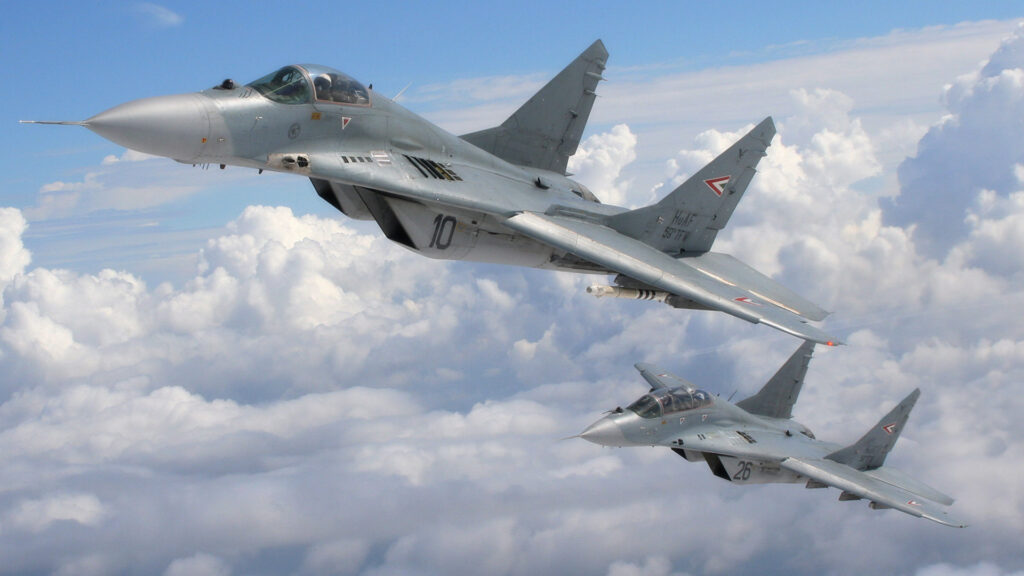MiG-29 History and Developments:
MiG-29 The Mikoyan MiG-29, a Soviet-designed twin-engine air superiority fighter, traces its roots back to the 1970s. Developed to counter Western aircraft like the American F-15 and F-16, the MiG-29 first entered service with the Soviet Air Forces in the mid-1980s. Over time, various versions and upgrades, such as the MiG-29K and MiG-29M, have been developed to enhance its capabilities.

Facts and Figures:
- First Flight: The MiG-29 made its maiden flight in 1977, showcasing its agility and advanced design.
- Speed and Range: With a top speed exceeding Mach 2 and a combat radius of several hundred kilometers, the MiG-29 is known for its high-speed capabilities and considerable range.
- Upgrades: Continuous upgrades have equipped the MiG-29 with modern avionics, radar systems, and air-to-air and air-to-ground weaponry.
- Variants: The MiG-29 has several variants, including those tailored for naval operations (MiG-29K) and multi-role capabilities (MiG-29M).
Role in the Indian Air Force (IAF):
- Interceptor: The MiG-29 serves as a key interceptor in the Indian Air Force, designed to engage and neutralize enemy aircraft entering Indian airspace.
- Air Superiority: Known for its air-to-air combat capabilities, the MiG-29 plays a vital role in ensuring air superiority in contested environments.
- Multi-Role Capability: The aircraft is equipped for multi-role missions, including ground attack and anti-ship operations, enhancing its versatility.
- Operational Reach and Quick Response: The MiG-29’s impressive range and speed contribute to its operational reach, allowing the IAF to cover vast distances efficiently. This quick response capability is crucial in addressing emerging threats, both within the region and beyond, ensuring that the aircraft can be rapidly deployed to safeguard Indian interests.
- Integration with Modern Avionics: Over the years, the MiG-29 in the IAF has undergone upgrades to integrate modern avionics and weaponry. These enhancements ensure that the aircraft remains technologically current, enhancing its effectiveness in contemporary aerial warfare scenarios.
- Human-Machine Interface and Pilot Training: The aircraft’s design emphasizes an efficient human-machine interface, providing the pilot with enhanced situational awareness and control. Pilot training programs for the MiG-29 focus on honing the skills necessary to leverage the aircraft’s capabilities fully.
Roles in Wars:
- Kargil War (1999): The MiG-29 played a significant role in the Kargil War, conducting air patrols and providing air cover to Indian forces operating in the region.
- Operation Safed Sagar (1999): During the Kargil conflict, MiG-29s were employed in Operation Safed Sagar, conducting airstrikes against enemy positions in the mountainous terrain.
- Peacekeeping Operations: MiG-29s have been utilized in various peacekeeping and surveillance missions, showcasing their adaptability beyond traditional combat roles.
- Combat Record: The MiG-29 has an impressive combat record, having seen action in conflicts worldwide, further validating its effectiveness in aerial warfare.
- Routine Border Patrols and Airspace Violations: The MiG-29s are routinely tasked with border patrols and surveillance along India’s vast borders. In instances of airspace violations or unauthorized entries by foreign aircraft, these fighters are scrambled to intercept and deter potential intruders. Their rapid response capabilities and air-to-air capabilities make them effective in such scenarios.
- International Exercises and Collaborations: Apart from direct combat roles, the MiG-29s have been actively involved in international exercises and collaborations. Joint training programs with other nations enhance the interoperability of the IAF and provide valuable insights into different operational tactics.
- Modernization and Upgrades: The MiG-29 fleet in the IAF has undergone modernization and upgrades to enhance its capabilities. The integration of modern avionics, radar systems, and weaponry ensures that these fighters remain technologically current, ready to meet the challenges of evolving air warfare scenarios.
In summary, the MiG-29 has been a stalwart in the Indian Air Force, contributing to air defense, air superiority, and multi-role missions. Its involvement in critical operations, including wartime scenarios, underscores its importance in India’s aerial defense strategy.